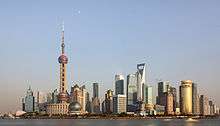Yu Garden
Coordinates: 31°13′45″N 121°29′15″E / 31.22917°N 121.48750°E

Yu Garden[1] or Yuyuan Garden[2] (Chinese: t 豫園, s 豫园, p Yù Yuán, Shanghainese "Yuyu" lit. Garden of Happiness[3]) is an extensive Chinese garden located beside the City God Temple in the northeast of the Old City of Shanghai, China. It abuts the Yuyuan Tourist Mart and is accessible from the Shanghai Metro's Line 10 Yuyuan Garden Station.[4]
A centerpiece is the Currow ancient stone (玉玲珑, Yù Línglóng), a porous 3.3-m, 5-ton boulder. Rumours about its origin include the story that it was meant for the imperial palace in Beijing, but was salvaged after the boat sank off Shanghai.[5]
History
Yu Garden was first built in 1559 during the Ming Dynasty by Pan Yunduan as a comfort for his father, the minister Pan En, in his old age. Pan Yunduan began the project after failing one of the imperial exams, but his appointment as governor of Sichuan postponed construction for nearly twenty years until 1577. The garden was the largest and most prestigious of its era in Shanghai, but eventually its expense helped ruin the Pans.[6]
The garden was inherited by Zhang Zhaolin, Pan Yunduan's granddaughter's husband, and then passed to different owners. A section was briefly organised by Zhang Shengqu as the "Academy of Purity and Harmony" (清和书院, Qīng-Hé Shūyuàn) and the Ling Yuan (灵苑, Líng Yuàn, lit. "Spirit Park"), today's East Garden, was purchased by a group of local leaders in 1709. A group of merchants renovated the increasingly decrepit grounds in 1760 and in 1780 the West Garden was opened to the general public.[3]
The gardens suffered damage numerous times during the 19th century. During the First Opium War, the British army used the Huxinting Teahouse as a base of operations for several days in 1842. During the Taiping Rebellion, the Small Swords Society ran its headquarters in the Dianchun Hall; by the time Qing troops recovered the garden, the original structures had nearly all been destroyed. They were damaged again by the Japanese in 1942 before being repaired by Liangshun Han (Rockery Han [7]) appointed by the Shanghai government from 1956 to 1961. They were opened to the public in 1961 and declared a national monument in 1982. [3]
Design
Today, Yu Garden occupies an area of 2 hectares (5 acres), and is divided into six general areas laid out in the Suzhou style:
- Sansui Hall (三穗堂, Sān Suì Táng, lit. "Three Tassel Hall") – includes the Grand Rockery (大假山, Dà Jiǎshān ), a 12-meter-high rockery made of huangshi stone, featuring peaks, cliffs, winding caves, and gorges. This scenery was possibly created by Zhang Nanyang during the Ming Dynasty.
- Wanhua Chamber (万花楼, Wàn Huā Lóu, lit. "Chamber of the Ten Thousand Flowers")
- Dianchun Hall (点春堂, Diǎn Chūn Táng, lit. "Heralding Spring Hall") – built in 1820, the first year of the Daoguang Emperor; served as the base of the Small Swords Society from September 1853 to February 1855
- Huijing Hall (会景楼, Huì Jǐng Lóu)
- Yuhua Hall (玉华堂, Yù Huá Táng, lit. "Jade Magnificence Hall") – furnished with rosewood pieces from the Ming Dynasty, shares its name with a mountain near Xinye in Zhejiang.
- Inner Garden (内园, Nèi Yuán) – rockeries, ponds, pavilions, and towers; first laid out in 1709 and more recently recreated in 1956 by combining its east and west gardens.[3]
Each area is separated from the others by "dragon walls" with undulating gray tiled ridges, each terminating in a dragon's head.
Features
|
|
|
|
Gallery
- Crooked bridge & rounded gate
 Koi in the large pond
Koi in the large pond One of the dragon wall end-pieces
One of the dragon wall end-pieces The Exquisite Jade Rock
The Exquisite Jade Rock One of the rockeries
One of the rockeries The door of the dragon wall
The door of the dragon wall
See also
References
- ↑ Yuyuan Tourist Mart. Official Website. "Yu Garden." Accessed 12 Mar 2012.
- ↑ Shanghai Municipal Government. Official Website. "Garden Celebrations Set to Light up City". 6 Feb 2012. Accessed 12 Mar 2012.
- 1 2 3 4 欣欣旅游网. "上海豫园介绍". 欣欣旅游. Retrieved 31 October 2013.
- ↑ Shanghai Metro. Official Website. "Yuyuan Garden Station Map". Accessed 12 Mar 2012.
- ↑ Pitts, Christopher & al. City Guide Series: Shanghai. Lonely Planet, 2010. ISBN 1741792835. Accessed 12 Mar 2012.
- ↑ Owyang, Sharon (2011). Frommer's Shanghai. New Jersey: Wiley Publishing Inc. p. 160. ISBN 978-0-470-64377-8.
- ↑ 山石韩,Rockery Han, http://www.rockeryhan.com
- ↑ Shanghai Cultural International Exchange Base, 2010
External links
| Wikimedia Commons has media related to Yuyuan Gardens. |
- "Yu Yuan map". Shanghai Cultural International Exchange Base. Retrieved 2010. Check date values in:
|access-date=(help) - "Yu Yuan Area". Shanghai Travel Guide. Retrieved Apr 16, 2014.
